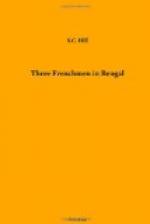[Footnote 89: The clerks.]
[Footnote 90: “This was the boaster Rai Durlabh Ram, who had already received much from me, but all the treasures of the Universe could not have freed him from the fear he felt at having to fight the English. He had with him as his second in command a good officer, Mir Madan, the only man I counted upon.” Law.]
[Footnote 91: Referring to Clive’s letter of the 7th of March, saying he wished to attack Chandernagore, but would await the Nawab’s orders at that place.]
[Footnote 92: By “agent” Law must mean simply an agent in the plot.]
[Footnote 93: Scrafton, in his “Reflections” (pp. 40 and 50), says, Siraj-ud-daula indulged in all sorts of debauchery; but his grandfather, in his last illness, made him swear on the Koran to give up drinking. He kept his oath, but probably his mind was affected by his previous excesses.]
[Footnote 94: Arzbegi, i.e. the officer who receives petitions.]
[Footnote 95: A preparation of betel-nut (areca-nut) is used by the natives of Hindustan as a digestive. When offered to a guest, it is a sign of welcome or dismissal. When sent by a messenger, it is an assurance of friendship and safe conduct.]
[Footnote 96: The Governor of Patna was Raja Ramnarain, a Hindu, with the rank of Naib only. It was considered unsafe to entrust so important a post to a Muhammadan, or an officer with the rank of Nawab.]
[Footnote 97: Orme MSS. India XI., p. 2779, No. 120.]
[Footnote 98: Ibid., India IX., p. 2294.]
[Footnote 99: Letter from Renault to Dupleix. Dated Chandernagore, Sept. 4, 1757.]
[Footnote 100: Broome (p. 154) gives his name as Mir Daood.]
[Footnote 101: The Council signed the Treaty with Mir Jafar on the 19th of May, but Mr. Watts’s first intimation of his readiness to join the English is, I believe, in a letter dated the 26th of April. Mir Jafar signed the Treaty early in June.]
[Footnote 102: So Suja-ud-daula, Nawab of Oudh, plundered the Nawab Mir Kasim, when the English drove him from Bengal in 1763.]
[Footnote 103: Broome (p. 154) says “a fakier, named Dana Shah, whose nose and ears he had ordered to be cut off thirteen months before, when on his march against the Nawaub of Purneah.”]
[Footnote 104: Orme MSS., India Office, and Clive correspondence at Walcot, vol. iv.]
[Footnote 105: The celebrated traveller. He quickly quarrelled with and left them.]
[Footnote 106: Province.]
[Footnote 107: Nawab of Oudh and father of Suja-ud-daula.]
[Footnote 108: I.e. the receiver of the rent or revenue.]
[Footnote 109: The regular winds of the various seasons are called monsoons, and are named after the point of the compass from which they blow.]
[Footnote 110: Alamgir II.]
[Footnote 111: Imad-ul-mulk, Ghazi-ud-din Khan.]




